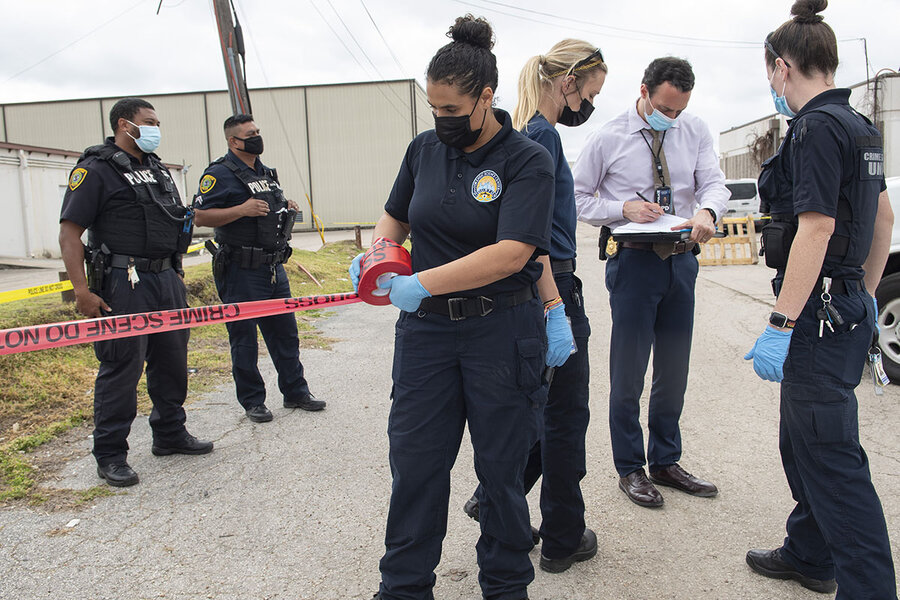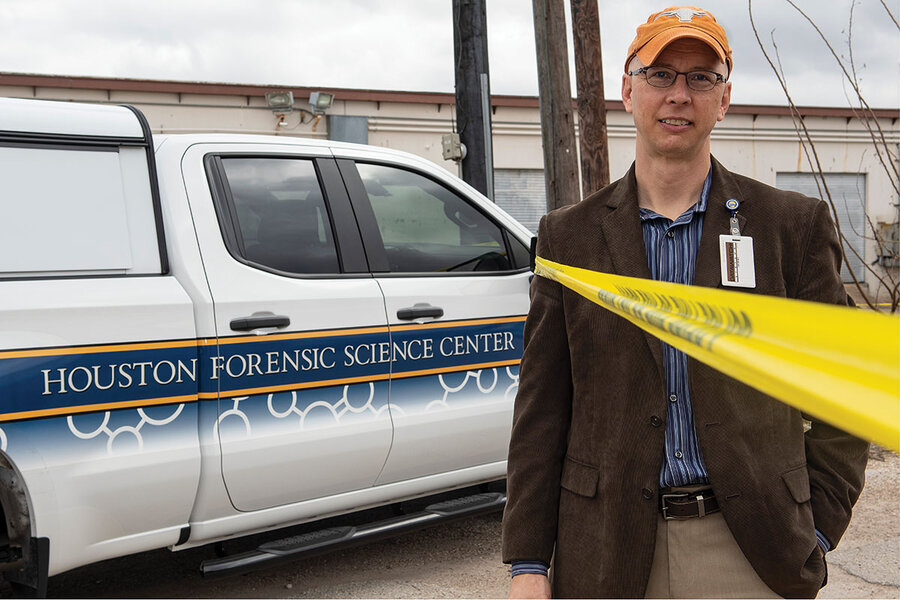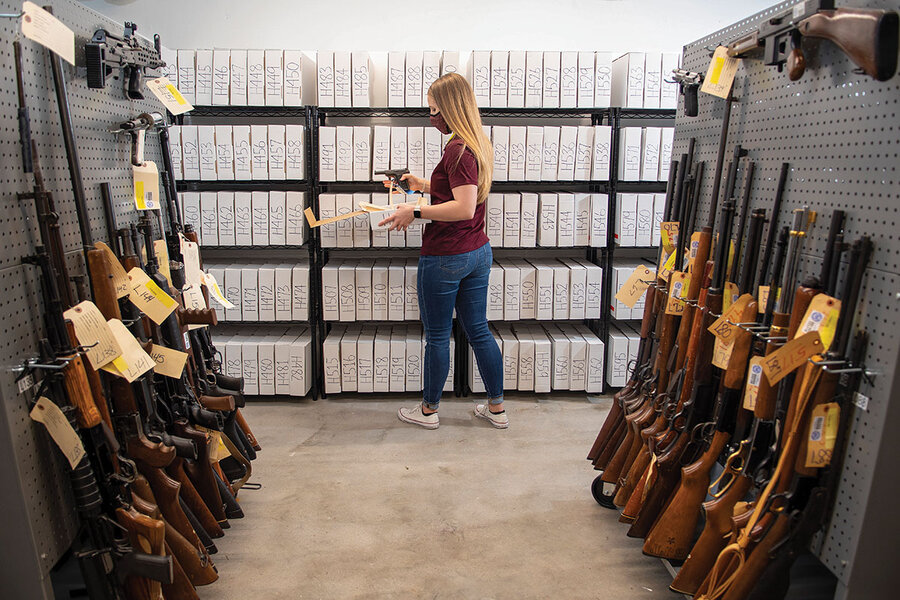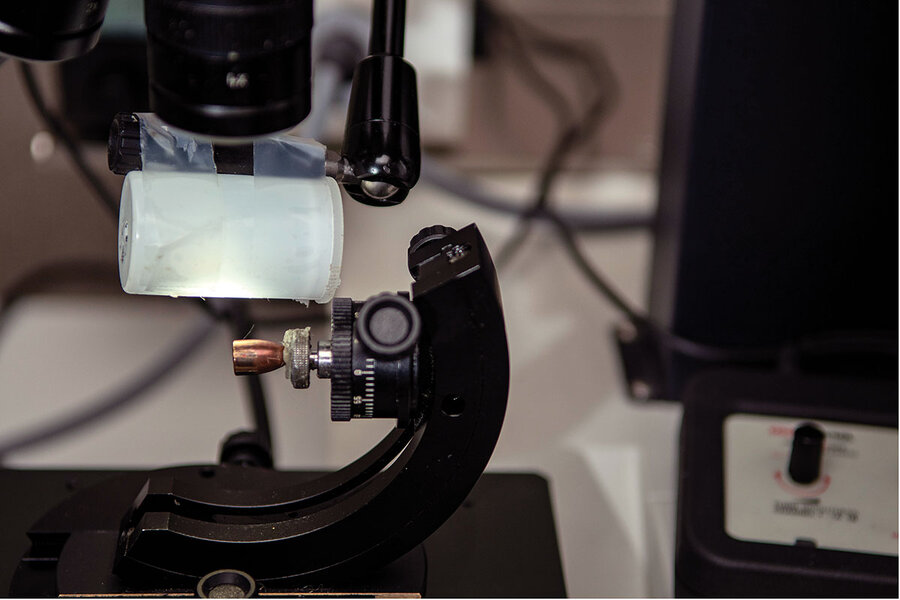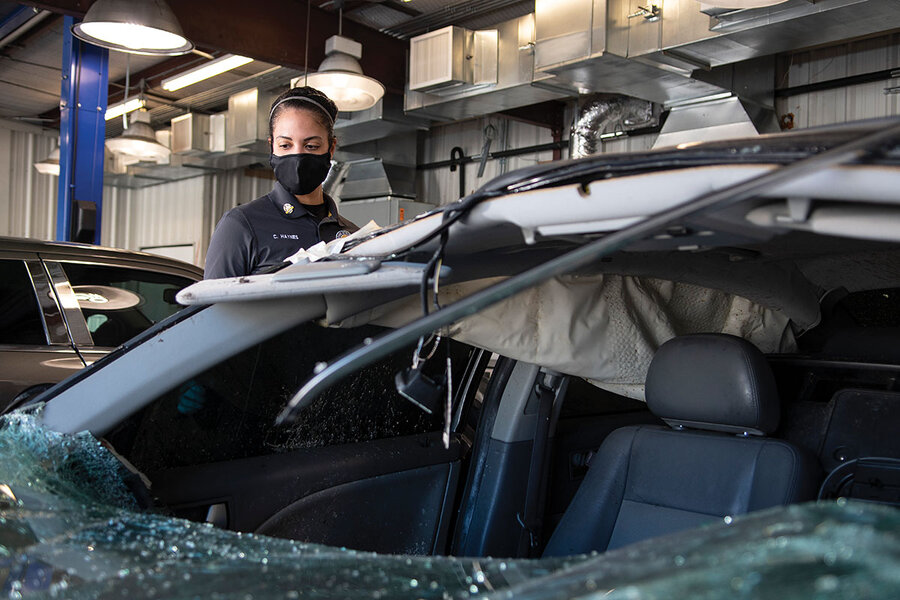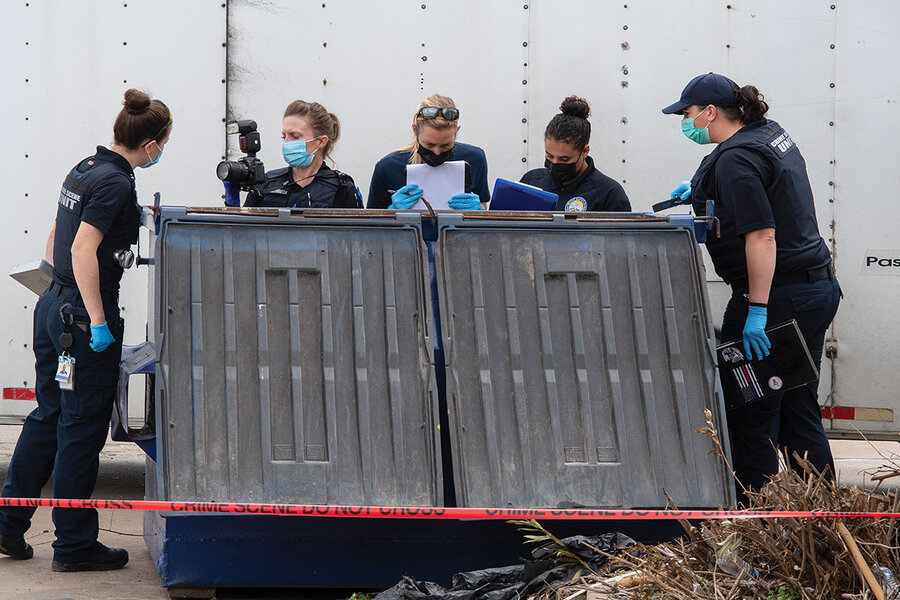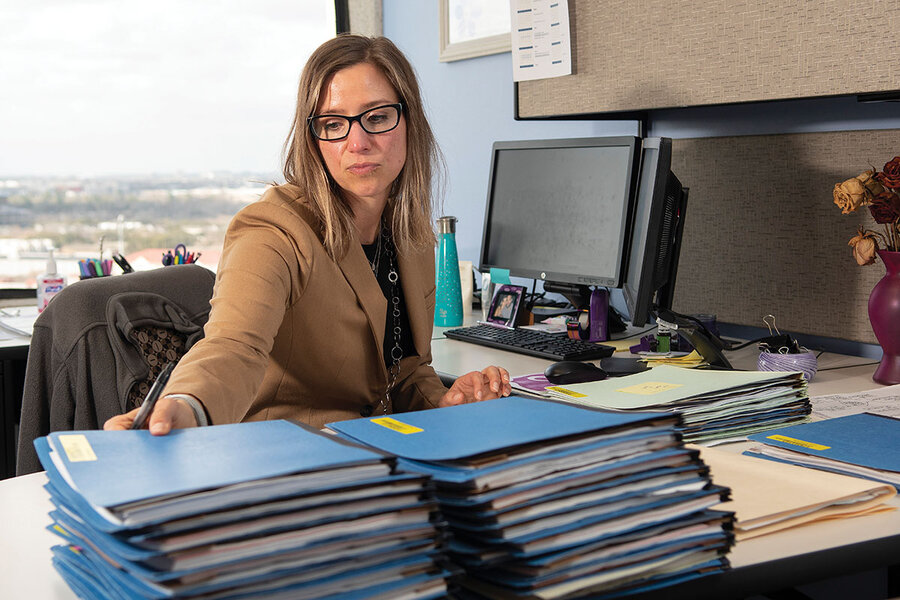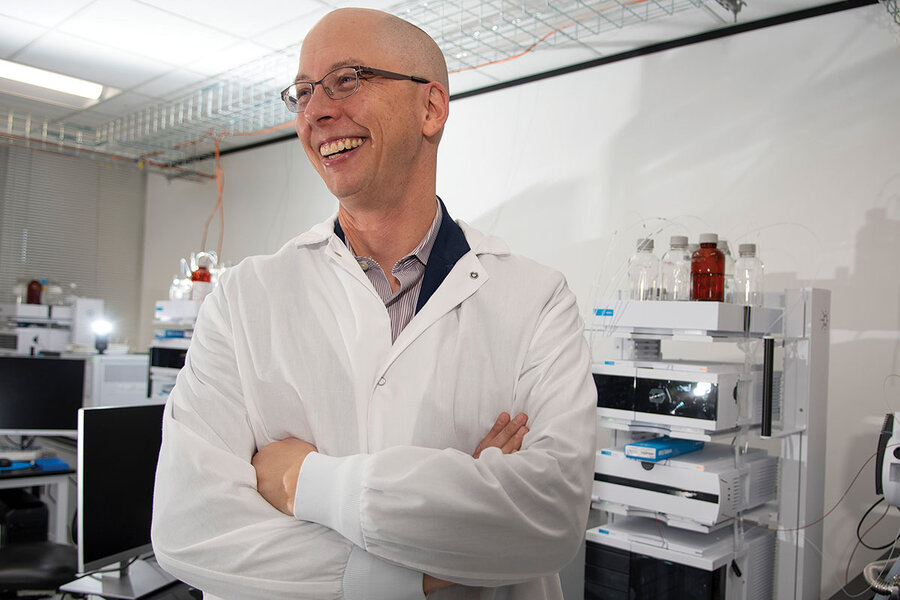CSI Houston: How a Texas lab has remade the science of forensics
Loading...
| Houston
“Concentrate on what cannot lie: the evidence.”
With that simple statement in the pilot episode of “CSI: Crime Scene Investigation,” lead character Gil Grissom voices perhaps the greatest myth about forensic science: its certainty.
Why We Wrote This
Hollywood portrays forensic science as nearly infallible. It isn’t. Now a Houston lab has become a model of reform, boosting trust in this critical part of the justice system.
Since 1989, bad forensic science has contributed to as many as a quarter of the 2,700-plus exonerations nationwide. Tens of thousands of cases have been found to be tainted by faulty forensic analysis or testimony.
The Houston Police Department had one such lab – consumed by years of mismanagement, neglect, and corruption – out of which grew the Houston Forensic Science Center. It has now become a model of reform. Its leader, Peter Stout – a toxicologist who is an unashamed nerd in a macabre high-tech toy store – sees forensic science as a civilizing force that offers “a just result ... something that actually is fair, evenhanded, and reflects, as close as you can understand, the actual truth.”
“The Houston lab is really doing something special and unique. ... It’s almost a unicorn among crime labs,” says Jessica Gabel Cino, a professor at Georgia State University College of Law.
We don’t know who the woman was, but we know she was sitting in the pickup truck when the burglary went south.
We know it was a September afternoon in 1977, when Cornelia and Ivan Stout returned home to find the truck in their driveway. We know the burglary soon turned into a murder: Ms. Stout was beaten unconscious, and her husband beaten to death with his own .22-caliber rifle – almost certainly by Kenneth Felder, who was shot and killed later that night and had Mr. Stout’s wallet in his pocket.
But here the truth gets murky: Who was the woman in the pickup truck?
Why We Wrote This
Hollywood portrays forensic science as nearly infallible. It isn’t. Now a Houston lab has become a model of reform, boosting trust in this critical part of the justice system.
Police found a couple of fingerprints on the truck – prints they said belonged to Cherrie Ann Porter. A jury believed them and convicted her of murder.
Ms. Porter may have never been there at all. After four years in prison, her conviction was overturned due to insufficient evidence: A couple of fingerprints were not enough.
To this day it’s unclear if justice in the case has been served or denied. Those decades of uncertainty and trauma might have driven the victim’s grandson to become a cop or a prosecutor. But Peter Stout couldn’t stop thinking about those fingerprints. He became a forensic scientist.
“It weighs on me having had a family that may have been complicit, or participatory, in a wrongful conviction,” says Dr. Stout. “And all that revolved around forensic evidence.”
His life has been defined by a quixotic search to bring scientific truth to the justice system, a search that has led him to the cutting edge of criminal justice reform, heading what some call the nation’s most advanced and innovative crime lab, the Houston Forensic Science Center (HFSC).
Forensic science is a civilizing force, Dr. Stout believes, because nothing can deliver truth, fairness, and equity to the criminal justice system better than the hard evidence crime labs can unearth and verify.
He sees the criminal justice system as a complex quagmire so rife with human error he isn’t surprised that 9 in 10 Americans want it reformed. In that quagmire, he says, are kernels of hard truth – and in forensic science he sees the best hope of finding them. It can offer “a just result,” he says, “something that actually is fair, evenhanded, and reflects, as close as you can understand, the actual truth.”
Forensic science failed Dr. Stout in his grandfather’s case. It compounded his uncertainty about other brushes with violence he says he experienced early in his life – from an improbable Mafia war in his middle-class Denver neighborhood to his yearslong sexual abuse by a neighbor.
A violent act, Dr. Stout knows better than most, can echo for generations – far beyond just the victim and perpetrator. But while he’s emerged with a successful and comfortable life, he doesn’t want forensic science failing anyone else.
Unashamedly nerdy
In a quiet corner office at HFSC, Dr. Stout does the numbers.
Through the window, downtown Houston sprawls around him, a bottomless pit of casework. The lab produces about 100 reports every day, and each report is about a crime. Each crime touches about 20 people, he estimates, so that’s about 2,000 lives the lab affects each day.
“Across a year, we alter hundreds of thousands of people’s lives,” he says. “The ongoing impact of that – that is the difference of whether civilization becomes more civilized or not.”
Popular culture has long portrayed the world of forensic science as technologically sleek, staffed by bespectacled scientists in lab coats, ingeniously analyzing evidence – and almost never making mistakes.
In reality, despite the existential stakes, many of these laboratories have lacked proper accreditation and oversight; been staffed by overworked, underfunded, and underqualified analysts; and been mired in scandal. And all this has contributed to cases where innocent people were convicted and guilty people walked free.
The Houston Police Department (HPD) had one such lab – consumed by years of mismanagement, neglect, and corruption – out of which grew the reform effort that is HFSC.
The current lab is an unusually well-insulated, well-oiled, and well-funded machine compared with its predecessor. And Dr. Stout is an atypical public face for criminal justice reform: One moment he can reflect somberly, through his own traumas, about the consequences of underinvesting in forensic science; the next, he’s cracking a toothy smile, joking about his baldness, or geeking out like a boy in a macabre, high-tech toy store – unashamedly nerdy.
Indeed, HFSC represents a nerdy brand of criminal justice reform – filled with jargon, acronyms, and huge implications.
Scientific evidence “is disproportionately persuasive evidence, and in that disproportionate power comes an awful lot of responsibility,” says Dr. Stout. “I’m not sure we’ve done a particularly good job historically of treating it appropriately.”
That may now be changing. Turning around one lab doesn’t turn around an entire justice system, he knows, but it’s a good start to a long journey.
The lab now operates independently, outside of – and on an equal footing with – police, prosecutors, and other players in Houston’s justice system. The 208-person staff – three-quarters of which is female, with an average age of 32 – works out of four floors and a few basement rooms in a glass-and-concrete tower shared with the district attorney’s office. Its about $30 million budget funds a “full service” laboratory, with sections for toxicology, DNA, firearms, and latent prints, among other disciplines.
And besides processing evidence for America’s fourth-largest city, HFSC has produced innovations – big and small – that are setting industry standards. It’s working with academics – and publishing research – to improve the validity and reliability of forensic disciplines. It’s a global leader on quality control – the practice of detecting mistakes and ensuring they don’t happen again.
“The Houston lab is really doing something special and unique. ... It’s almost a unicorn among crime labs,” says Jessica Gabel Cino, a professor at Georgia State University College of Law.
In many respects, HFSC is an outlier among the country’s roughly 400 crime labs. Most remain inside law enforcement agencies, with constrained budgets and staff. Yet they all produce evidence and testimony that are disproportionately persuasive because they come from the presumably precise and hermetically sealed world of forensic science.
The “CSI” problem
“Concentrate on what cannot lie: the evidence.”
With that simple statement in the pilot episode of “CSI: Crime Scene Investigation,” lead character Gil Grissom voices perhaps the greatest myth about forensic science: its certainty.
For decades forensic science has been held up – and has held itself up – as nearly infallible. Did this hair come from that head? Or this bullet from that gun? The crime labs would know.
But did they?
Certainty crumbled in 2009, with the seismic conclusion of a National Academy of Sciences report: When it came to “matching” evidence from a crime to a specific individual or source, no forensic method besides nuclear DNA analysis has “the capacity to consistently, and with a high degree of certainty” make those matching claims.
Decades of scientific evidence being overstated or misrepresented – intentionally or otherwise – has had devastating consequences. Since 1989, bad forensic science has contributed to a quarter of 2,700-plus exonerations nationwide, according to the National Registry of Exonerations. Tens of thousands of cases have been found to be tainted by faulty forensic analysis or testimony.
“We’ve made assumptions and given latitude to less-than-rigorous work,” says Dr. Stout. “It’s part of why people don’t trust the justice system.”
The kicker is that no forensic discipline may ever be 100% reliable. But compared with nonscientific forms of evidence – such as eyewitness testimony, which is now widely questioned – forensics “is closer to [being] that kernel of truth,” he says. That uncertainty should in fact be comforting, he adds.
“We are wickedly prone to believing absolute statements,” he continues. “Evidence that should carry much more weight comes with that hard but very necessary conversation about ... its limitations.”
Ultimately, reforming forensic science needs both practical and cultural shifts, from improving standards and procedures to embracing uncertainty and limitations. Analysts being clear about what they know – and don’t know – is especially critical given the weight juries give scientific evidence.
“We have to take the responsibility to produce [forensic evidence] as rigorously as we can,” says Dr. Stout. “Because the number of trials that swing on one piece of physical evidence is really terrifying.”
Beyond the yellow tape
The body has been in the dumpster for a few hours at least – maybe a dozen. It’s a male, and he was shot – maybe in the head.
The dumpster sits under a warm, overcast February sky, behind a Brutalist strip mall in an industrial corner of Houston’s west side. The buzz of highway traffic fills the air.
Two Houston police detectives in shirts and ties orbit the dumpster, which is cordoned off by yellow tape. They pause every few moments to study some new detail or jot down notes. A dumpster is a logical place to dispose of a body, but maybe not in front of the store surveillance camera trained on it. After reviewing the footage with a police detective, investigators from HFSC’s crime scene unit (CSU) put up a narrower cordon of red tape.
Of all the reforms HFSC is cultivating, the red tape is a small but significant one. It marks the most sensitive area of a crime scene; you can’t cross it unless you’re in full protective gear. It’s a product of the CSU becoming fully civilianized, not staffed by police officers like it was in the past – and like many CSUs still are.
Crime scenes are where investigations start. It’s where the first mistakes can be made, and where the first biases can take root. Having a civilian CSU on scene has let confidence and trust permeate the justice system, says Stacey Mitchell, chair of the HFSC board of directors. In the past “we had officers investigating officer-involved shootings,” she adds. “Because we have civilianized crime scene investigators who are specially trained, [now] everyone is confident that the evidence is the evidence.”
Forensic information travels through a long, meticulous chain of custody, however, and a more secure and expertly managed crime scene doesn’t eliminate the possibility of mistakes down the line.
Which is why HFSC’s most lauded reform has nothing to do with the collection or testing of actual evidence. It’s the testing of the lab itself.
Faking evidence, with purpose
Last year, to verify what the forensic biology division was doing, an HFSC analyst needed some fake evidence. Uncontaminated female DNA, to be precise. So she lifted her hair, swabbed the back of her neck, and sealed it like genuine crime scene evidence in a container to send to the lab.
A well-functioning research facility with well-trained staff would be expected to analyze it and find only female DNA. So when the final analysis revealed a mix of female and male DNA, the analyst had to investigate.
The male DNA ended up being from the husband of the analyst who swabbed her neck – the first of three cases that year of HFSC accidentally contaminating its own “blind test.” Dr. Stout is now considering publishing a paper about it to teach DNA analysts around the country how easy it can be to contaminate samples.
If HFSC has a crown jewel, it’s the seven-person (and all-female) quality division. And if the lab has a standout innovation, it’s the division’s blind testing program. Each year, lab scientists create hundreds of pieces of fake evidence or meticulously fill burner phones with false content like apps, social media posts, and texts to probe for flaws in how the lab is functioning.
“No other lab in the world has done that,” says Brandon Garrett, a Duke University law professor and author of “Autopsy of a Crime Lab: Exposing the Flaws in Forensics.”
Of the 25,000 requests the lab completes each year, about 5% are blind tests. That’s a ratio hand-picked by Dr. Stout – frequent enough that analysts expect them, infrequent enough to be hard to predict. Other labs may do a handful a year, and most don’t do this at all.
The constant surveillance could make for a toxic workplace. But Dr. Stout and the lab’s department heads make it a friendly cat-and-mouse game throughout HFSC. Analysts who identify a blind test win a Starbucks gift card. Those who don’t owe Dr. Stout $1.
More importantly, the lab has normalized a workplace culture that sees mistakes as inevitable and as opportunities to improve, not punish.
“Without that quality check, your answer, even though you have it ... isn’t necessarily the right answer,” says Erika Ziemak, director of the quality division. “Part of what we do every day [is] making sure that we are, as [Dr. Stout] says, the right answer at the right time.”
Independence days
But the foundation of it all is the parity HFSC enjoys in Houston’s justice system. Independence from law enforcement was key to the city’s creation of HFSC in 2014. But in spinning off HPD’s crime lab and CSU to form the center, Houston officials went even further: giving HFSC a corporate, quasi-governmental structure.
Dr. Stout’s official title is president and chief executive officer, and he reports to a diverse nine-member board of directors of scientists, lawyers, police, and those wrongfully convicted. The board reports to local government the way police and prosecutors do, making their own personnel decisions and budget requests.
The result is not only that a scientist, rather than a law enforcement officer, is in charge, but also that the facility has a bigger budget with a larger, higher-paid, better-equipped staff than most crime labs. And there’s less bureaucracy: Dr. Stout can tinker himself with a new gadget – a drone – to help CSU digitally map crime scenes, which in turn reduces time on-site so they can respond to more than the meager 1% of aggravated assaults they got to last year. And he can provide suitable mental health support for staff members who are exposed daily to the unfiltered horrors of society.
“Tucked away in a police department, [the lab] might not be a very high priority,” says Sandra Thompson, a professor at the University of Houston Law Center who spent seven years on HFSC’s board.
The old HPD crime lab wasn’t just tucked away; it was getting rained on.
“We were stuck in a closet like mushrooms; nobody ever looked at us,” says James Miller, whose 31-year career straddles the old lab and the new, where he heads the seized drugs division.
A leaky roof went unfixed for years, soaking and destroying evidence. The backlog of untested rape kits hit 6,600 at one point, with one victim waiting five years to have hers tested. Senior positions went unfilled, and when misconduct was discovered, punishment was usually lenient. An independent investigation of the HPD lab uncovered four cases between 1998 and 2000 of “dry labbing” (fabrication of or tampering with evidence, a cardinal sin for scientists).
In 2003 The New York Times asked if the HPD crime lab was the worst in the country, or if – more troublingly – it was “typical.” Evidence since then suggests it wasn’t unusual. The biggest scandal of them all is still unfolding in Massachusetts, where tens of thousands of criminal charges have been dropped because of misconduct by two former state chemists eight years ago. St. Paul, Minnesota, closed its crime lab in 2012 after investigations found “major” errors in nearly every aspect of the lab’s work. In 2015 the FBI admitted to presenting flawed testimony on hair fiber comparisons in court for decades.
But as bad as the intentional misconduct is, systemic flaws – underfunding and lack of oversight and standards – are bigger problems, experts say. Reform on that scale takes time, Dr. Stout knows, but he points to the HPD lab. It’s the “archetype of the failed laboratory,” and it was fixed.
“It’s not easy, but you can actually make a difference,” he adds. “You can get to a point where people begin to start trusting what comes out of [labs] again.”
Light in the darkness
Dr. Stout still doesn’t have an elevator pitch for a politician on the importance of forensic science. It’s just too Byzantine.
But if he could take the stairs with a government official, he’d probably talk about his own journey. They would have to walk up the 18 flights to HFSC’s top floor. Slowly.
What happened with his grandfather and Ms. Porter changed his life forever, but he’d already had more exposure to violence than your average preteen. A neighbor was gunned down in a mob hit when he was 3 years old – an age where you might think you imagined something like that. For a long time Dr. Stout did.
That Mafia war in his Denver suburb did happen. But much of his younger years, after his grandfather’s murder, remain wreathed in darkness. His family had all retreated into private shells of grief. No one was really looking out for him, he says, and for several years a neighborhood boy sexually assaulted him.
He doesn’t remember much – in part because he doesn’t want to. But as he’s grown older, as his forensic science career has progressed, he says he’s begun to see through the darkness with a bit more clarity. It’s made him think about trauma, and how it changes memories and lives. It’s made him think differently about those fingerprints on that truck in 1977.
He won’t ever know if Ms. Porter was in that truck. And he may never want to shine a light on every dark trauma in his past. But now he hopes that the forensic science lab he runs can provide a clarity he never enjoyed.
“I keep having to come back to look for those little crystalline facts to try and ground my fractured and fragmented memories,” he says. “I get a lot of assurance out of those facts. And I think what that has led me to is: Others have to have that same thing.”




